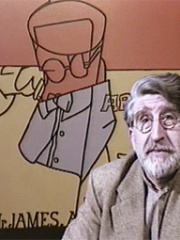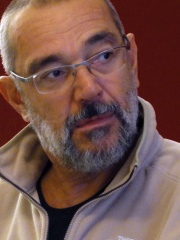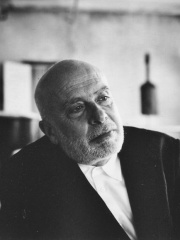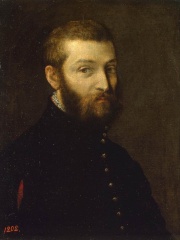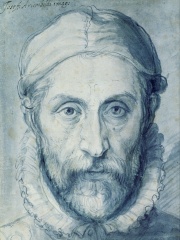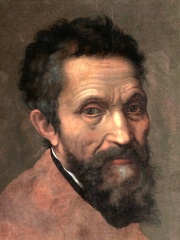
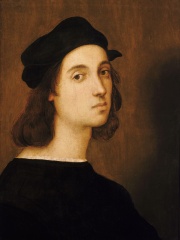
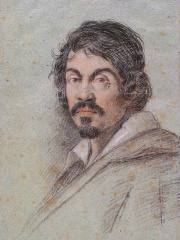
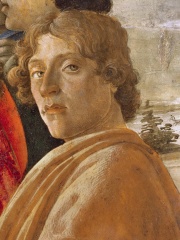
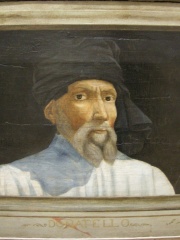
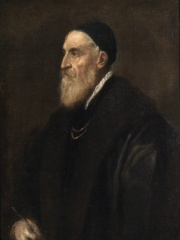
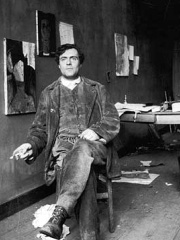
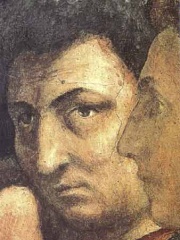
The Most Famous
PAINTERS from Italy
Top 10
The following people are considered by Pantheon to be the top 10 most legendary Italian Painters of all time. This list of famous Italian Painters is sorted by HPI (Historical Popularity Index), a metric that aggregates information on a biography's online popularity. Visit the rankings page to view the entire list of Italian Painters.

1. Michelangelo (1475 - 1564)
With an HPI of 93.54, Michelangelo is the most famous Italian Painter. His biography has been translated into 210 different languages on wikipedia.
Michelangelo di Lodovico Buonarroti Simoni (6 March 1475 – 18 February 1564), known mononymously as Michelangelo, was an Italian sculptor, painter, architect, and poet of the High Renaissance. He was born in the Republic of Florence but was mostly active in Rome from his 30s onwards. His work was inspired by models from classical antiquity and had a lasting influence on Western art. Michelangelo's creative abilities and mastery in a range of artistic arenas define him as an archetypal Renaissance man, along with his rival and elder contemporary, Leonardo da Vinci. Given the sheer volume of surviving correspondence, sketches, and reminiscences, Michelangelo is one of the best-documented artists of the 16th century. He was lauded by contemporary biographers as the most accomplished artist of his era. Michelangelo achieved fame early. Two of his best-known works, the Pietà and David, were sculpted before the age of 30. Although he did not consider himself a painter, Michelangelo created two of the most influential frescoes in the history of Western art: the scenes from Genesis on the ceiling of the Sistine Chapel in Rome, and The Last Judgment on its altar wall. His design of the Laurentian Library pioneered Mannerist architecture. At the age of 71, he succeeded Antonio da Sangallo the Younger as the architect of St. Peter's Basilica. Michelangelo transformed the plan so that the Western end was finished to his design, as was the dome, with some modification, after his death. Michelangelo was the first Western artist whose biography was published while he was alive. Three biographies were published during his lifetime. One of them, by Giorgio Vasari, proposed that Michelangelo's work transcended that of any artist living or dead, and was "supreme in not one art alone but in all three". In his lifetime, Michelangelo was often called Il Divino ("the divine one"). His contemporaries admired his terribilità—his ability to instill a sense of awe in viewers of his art. Attempts by subsequent artists to imitate the expressive physicality of Michelangelo's style contributed to the rise of Mannerism, a short-lived movement in Western art between the High Renaissance and the Baroque.

2. Raphael (1483 - 1520)
With an HPI of 90.99, Raphael is the 2nd most famous Italian Painter. His biography has been translated into 169 different languages.
Raffaello Sanzio da Urbino (Italian: [raffaˈɛllo ˈsantsjo da urˈbiːno]; March 28 or April 6, 1483 – April 6, 1520), now generally known in English as Raphael (UK: RAF-ay-əl, US: RAF-ee-əl, RAY-fee-, RAH-fy-EL), was an Italian painter and architect of the High Renaissance. His work is admired for its clarity of form, ease of composition, and visual achievement of the Neoplatonic ideal of human grandeur. Together with Leonardo da Vinci and Michelangelo, he forms the traditional trinity of great masters of that period. His father Giovanni Santi was court painter to the ruler of the small but highly cultured city of Urbino. He died when Raphael was eleven, and Raphael seems to have played a role in managing the family workshop from this point. He probably trained in the workshop of Pietro Perugino, and was described as a fully trained "master" by 1500. He worked in or for several cities in north Italy until in 1508 he moved to Rome at the invitation of Pope Julius II, to work on the Apostolic Palace at the Vatican. He was given a series of important commissions there and elsewhere in the city, and began to work as an architect. He was still at the height of his powers at his death in 1520. Raphael was enormously productive, running an unusually large workshop and, despite his early death at 37, leaving a large body of work. His career falls naturally into three phases and three styles, first described by Giorgio Vasari: his early years in Umbria, then a period of about four years (1504–1508) absorbing the artistic traditions of Florence, followed by his last hectic and triumphant twelve years in Rome, working for two popes and their close associates. Many of his works are found in the Vatican Palace, where the frescoed Raphael Rooms were the central, and the largest, work of his career. The best known work is The School of Athens in the Vatican Stanza della Segnatura. After his early years in Rome, much of his work was executed by his workshop from his drawings, with considerable loss of quality. He was extremely influential in his lifetime, though outside Rome his work was mostly known from his collaborative printmaking. After his death, the influence of his great rival Michelangelo exceeded his until the 18th and 19th centuries, when Raphael's more serene and harmonious qualities were again regarded as the highest models. Thanks to the influence of art historian Johann Joachim Winckelmann, his work became a formative influence on Neoclassical painting, but his techniques would later be explicitly and emphatically rejected by groups such as the Pre-Raphaelite Brotherhood.

3. Caravaggio (1571 - 1610)
With an HPI of 87.57, Caravaggio is the 3rd most famous Italian Painter. His biography has been translated into 98 different languages.
Michelangelo Merisi da Caravaggio (also Michele Angelo Merigi or Amerighi da Caravaggio; 29 September 1571 – 18 July 1610), known mononymously as Caravaggio, was an Italian painter active in Rome for most of his artistic life. During the final four years of his life, he moved between Naples, Malta, and Sicily. His paintings have been characterized by art critics as combining a realistic observation of the human state, both physical and emotional, with a dramatic use of lighting, which had a formative influence on Baroque painting. Caravaggio employed close physical observation with a dramatic use of chiaroscuro that came to be known as tenebrism. He made the technique a dominant stylistic element, transfixing subjects in bright shafts of light and darkening shadows. Caravaggio vividly expressed crucial moments and scenes, often featuring violent struggles, torture, and death. He worked rapidly with live models, preferring to forgo drawings and work directly onto the canvas. His inspiring effect on the new Baroque style that emerged from Mannerism was profound. His influence can be seen directly or indirectly in the work of Peter Paul Rubens, Jusepe de Ribera, Gian Lorenzo Bernini, Velázquez and Rembrandt. Artists heavily under his influence were called the "Caravaggisti" (or "Caravagesques"), as well as tenebrists or tenebrosi ("shadowists"). Caravaggio trained as a painter in Milan before moving to Rome when he was in his twenties. He developed a considerable name as an artist and as a violent, touchy and provocative man. He killed Ranuccio Tommasoni in a brawl, which led to a death sentence for murder and forced him to flee to Naples. There he again established himself as one of the most prominent Italian painters of his generation. He travelled to Malta and on to Sicily in 1607 and pursued a papal pardon for his sentence. In 1609, he returned to Naples, where he was involved in a violent clash; his face was disfigured, and rumours of his death circulated. Questions about his mental state arose from his erratic and bizarre behavior. He died in 1610 under uncertain circumstances while on his way from Naples to Rome. Reports stated that he died of a fever, but suggestions have been made that he was murdered or that he died of lead poisoning. Caravaggio's innovations inspired Baroque painting, but the latter incorporated the drama of his chiaroscuro without the psychological realism. The style evolved and fashions changed, and Caravaggio fell out of favour. In the 20th century, interest in his work revived, and his importance to the development of Western art was reevaluated. The 20th-century art historian André Berne-Joffroy stated: "What begins in the work of Caravaggio is, quite simply, modern painting."

4. Sandro Botticelli (1445 - 1510)
With an HPI of 87.24, Sandro Botticelli is the 4th most famous Italian Painter. His biography has been translated into 101 different languages.
Alessandro di Mariano di Vanni Filipepi (c. 1445 – May 17, 1510), better known as Sandro Botticelli ( BOT-ih-CHEL-ee; Italian: [ˈsandro bottiˈtʃɛlli]) or simply Botticelli, was an Italian painter of the Early Renaissance. Botticelli's posthumous reputation suffered until the late 19th century, when he was rediscovered by the Pre-Raphaelites who stimulated a reappraisal of his work. Since then, his paintings have been seen to represent the linear grace of late Italian Gothic and some Early Renaissance painting, even though they date from the latter half of the Italian Renaissance period. In addition to the mythological subjects for which he is best known today, Botticelli painted a wide range of religious subjects (including dozens of renditions of the Madonna and Child, many in the round tondo shape) and also some portraits. His best-known works are The Birth of Venus and Primavera, both in the Uffizi in Florence, which holds many of Botticelli's works. Botticelli lived all his life in the same neighbourhood of Florence; his only significant times elsewhere were the months he spent painting in Pisa in 1474 and the Sistine Chapel in Rome in 1481–82. Only one of Botticelli's paintings, the Mystic Nativity (National Gallery, London) is inscribed with a date (1501), but others can be dated with varying degrees of certainty on the basis of archival records, so the development of his style can be traced with some confidence. He was an independent master for all the 1470s, which saw his reputation soar. The 1480s were his most successful decade, the one in which his large mythological paintings were completed along with many of his most famous Madonnas. By the 1490s, his style became more personal and to some extent mannered. His last works show him moving in a direction opposite to that of Leonardo da Vinci (seven years his junior) and the new generation of painters creating the High Renaissance style, and instead returning to a style that many have described as more Gothic or "archaic".
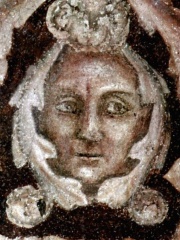
5. Giotto (1267 - 1337)
With an HPI of 85.03, Giotto is the 5th most famous Italian Painter. His biography has been translated into 90 different languages.
Giotto di Bondone (Italian: [ˈdʒɔtto di bonˈdoːne]; c. 1267 – January 8, 1337), known mononymously as Giotto, was an Italian painter and architect from Florence during the Late Middle Ages. He worked during the Gothic and Proto-Renaissance period. Giotto's contemporary, the banker and chronicler Giovanni Villani, wrote that Giotto was "the most sovereign master of painting in his time, who drew all his figures and their postures according to nature" and of his publicly recognized "talent and excellence". Giorgio Vasari described Giotto as making a decisive break from the prevalent Byzantine style and as initiating "the great art of painting as we know it today, introducing the technique of drawing accurately from life, which had been neglected for more than two hundred years". Giotto's masterwork is the decoration of the Scrovegni Chapel, in Padua, also known as the Arena Chapel, which was completed around 1305. The fresco cycle depicts the Life of the Virgin and the Life of Christ. It is regarded as one of the supreme masterpieces of the Early Renaissance. The fact that Giotto painted the Arena Chapel and that he was chosen by the Commune of Florence in 1334 to design the new campanile (bell tower) of the Florence Cathedral are among the few certainties about his life. Almost every other aspect of it is subject to controversy: his birth date, his birthplace, his appearance, his apprenticeship, the order in which he created his works, whether he painted the famous frescoes in the Upper Basilica of Saint Francis in Assisi, and his burial place.

6. Donatello (1386 - 1466)
With an HPI of 84.83, Donatello is the 6th most famous Italian Painter. His biography has been translated into 100 different languages.
Donato di Niccolò di Betto Bardi (c. 1386 – 13 December 1466), known mononymously as Donatello (English: ; Italian: [donaˈtɛllo]), was an Italian sculptor of the Renaissance period. Born in Florence, he studied classical sculpture and used his knowledge to develop an Early Renaissance style of sculpture. He spent time in other cities, where he worked on commissions and taught others; his periods in Rome, Padua, and Siena introduced to other parts of Italy the techniques he had developed in the course of a long and productive career. His David was the first freestanding nude male sculpture since antiquity; like much of his work, it was commissioned by the Medici family. He worked with stone, bronze, wood, clay, stucco, and wax, and used glass in inventive ways. He had several assistants, with four perhaps being a typical number. Although his best-known works are mostly statues executed in the round, he developed a new, very shallow, type of bas-relief for small works, and a good deal of his output was architectural reliefs for pulpits, altars and tombs, as well as Madonna and Childs for homes. Broad, overlapping phases can be seen in his style, beginning with the development of expressiveness and classical monumentality in statues, then developing energy and charm, mostly in smaller works. Early on, he veered away from the International Gothic style he learned from Lorenzo Ghiberti, with classically informed pieces, and further on a number of stark, even brutal pieces. The sensuous eroticism of his most famous work, the bronze David, is very rarely seen in other pieces.

7. Titian (1488 - 1576)
With an HPI of 84.62, Titian is the 7th most famous Italian Painter. His biography has been translated into 91 different languages.
Tiziano Vecellio (Italian: [titˈtsjaːno veˈtʃɛlljo]; c. 1488/1490 – 27 August 1576), Latinized as Titianus, hence known in English as Titian ( TISH-ən), was an Italian Renaissance painter. The most important artist of Renaissance Venetian painting, he was born in Pieve di Cadore, near Belluno. Titian was one of the most versatile of Italian painters, equally adept with portraits, landscape backgrounds, and mythological and religious subjects. His painting methods, particularly in the application and use of colour, exerted a profound influence not only on painters of the late Italian Renaissance, but on future generations of Western artists. His career was successful from the start, and he became sought after by patrons, initially from Venice and its possessions, then joined by the north Italian princes, and finally the Habsburgs and the papacy. Along with Giorgione, he is considered a founder of the Venetian school of Italian Renaissance painting. In 1590, the painter and art theorist Giovanni Paolo Lomazzo described Titian as "the sun amidst small stars not only among the Italians but all the painters of the world". During his long life, Titian's artistic manner changed drastically, but he retained a lifelong interest in colour. Although his mature works may not contain the vivid, luminous tints of his early pieces, they are remarkable and original in their loose brushwork and subtlety of tone.

8. Amedeo Modigliani (1884 - 1920)
With an HPI of 82.99, Amedeo Modigliani is the 8th most famous Italian Painter. His biography has been translated into 79 different languages.
Amedeo Clemente Modigliani (US: ; Italian: [ameˈdɛːo modiʎˈʎaːni]; 12 July 1884 – 24 January 1920) was an Italian painter and sculptor of the École de Paris who worked mainly in France. He is known for portraits and nudes in a modern style characterised by a surreal elongation of faces, necks, and figures — works that were not received well during his lifetime, but later became much sought after. Modigliani was born and spent his youth in Italy, where he studied the art of antiquity and the Renaissance. In 1906, he moved to Paris, where he came into contact with such artists as Pablo Picasso and Constantin Brâncuși. By 1912, Modigliani was exhibiting highly stylised sculptures with Cubists of the Section d'Or group at the Salon d'Automne. Modigliani's oeuvre includes paintings and drawings. From 1909 to 1914, he devoted himself mainly to sculpture. His main subjects were portraits and full figures, both in images and in the sculpture. Modigliani had little success while alive but after his death achieved great popularity. He died of tubercular meningitis, at the age of 35, in Paris.

9. Masaccio (1401 - 1428)
With an HPI of 82.16, Masaccio is the 9th most famous Italian Painter. His biography has been translated into 74 different languages.
Masaccio (UK: , US: ; Italian: [maˈzattʃo]; December 21, 1401 – summer 1428), born Tommaso di Ser Giovanni di Simone, was a Florentine artist who is regarded as the first great Italian painter of the Quattrocento period of the Italian Renaissance. According to Vasari, Masaccio was the best painter of his generation because of his skill at imitating nature, recreating lifelike figures and movements as well as a convincing sense of three-dimensionality. He employed nudes and foreshortenings in his figures. This had seldom been done before him. The name Masaccio is a humorous version of Maso (short for Tommaso), meaning "clumsy" or "messy" Tom. The name may have been created to distinguish him from his principal collaborator, also called Maso, who came to be known as Masolino ("little/delicate Tom"). Despite his brief career, he had a profound influence on other artists and is considered to have started the Early Italian Renaissance in painting with his works in the mid- and late-1420s. He was one of the first to use linear perspective in his painting, employing techniques such as vanishing point in art for the first time. He moved away from the International Gothic style and elaborate ornamentation of artists like Gentile da Fabriano to a more naturalistic mode that employed perspective and chiaroscuro for greater realism. Masaccio died at the age of twenty-six and little is known about the exact circumstances of his death. Upon hearing of Masaccio's death, Filippo Brunelleschi said: "We have suffered a great loss."
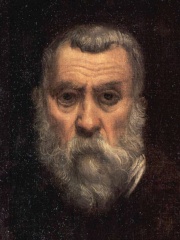
10. Tintoretto (1518 - 1594)
With an HPI of 81.96, Tintoretto is the 10th most famous Italian Painter. His biography has been translated into 76 different languages.
Jacopo Robusti (late September or early October 1518 – 31 May 1594), best known as Tintoretto ( TIN-tə-RET-oh; Italian: [tintoˈretto], Venetian: [tiŋtoˈɾeto]), was an Italian Renaissance painter of the Venetian school. His contemporaries both admired and criticised the speed with which he painted and the unprecedented boldness of his brushwork. For his phenomenal energy in painting he was termed il Furioso (Italian for 'the Furious'). His work is characterised by muscular figures, dramatic gestures and bold use of perspective, in the Mannerist style.
People
Pantheon has 265 people classified as Italian painters born between 500 BC and 1964. Of these 265, 3 (1.13%) of them are still alive today. The most famous living Italian painters include Valerio Adami, Andrea Benetti, and Francesco Clemente. The most famous deceased Italian painters include Michelangelo, Raphael, and Caravaggio.
Living Italian Painters
Go to all RankingsValerio Adami
1935 - Present
HPI: 58.85
Andrea Benetti
1964 - Present
HPI: 56.41
Francesco Clemente
1952 - Present
HPI: 56.06
Deceased Italian Painters
Go to all RankingsMichelangelo
1475 - 1564
HPI: 93.54
Raphael
1483 - 1520
HPI: 90.99
Caravaggio
1571 - 1610
HPI: 87.57
Sandro Botticelli
1445 - 1510
HPI: 87.24
Giotto
1267 - 1337
HPI: 85.03
Donatello
1386 - 1466
HPI: 84.83
Titian
1488 - 1576
HPI: 84.62
Amedeo Modigliani
1884 - 1920
HPI: 82.99
Masaccio
1401 - 1428
HPI: 82.16
Tintoretto
1518 - 1594
HPI: 81.96
Paolo Veronese
1528 - 1588
HPI: 81.44
Giuseppe Arcimboldo
1526 - 1593
HPI: 80.96
Overlapping Lives
Which Painters were alive at the same time? This visualization shows the lifespans of the 25 most globally memorable Painters since 1700.

